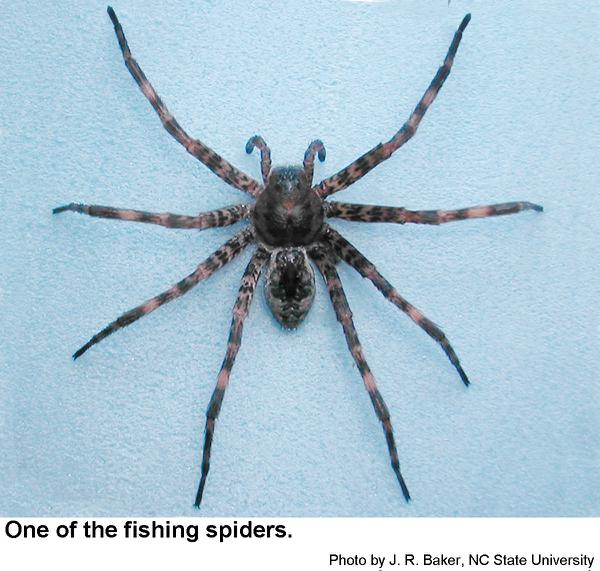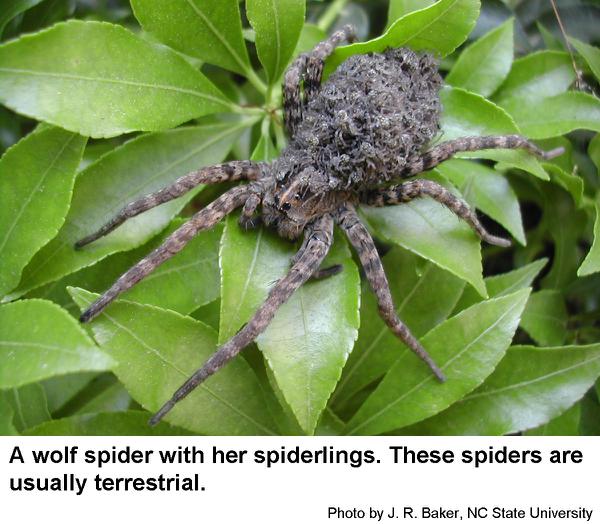Description and Biology
Fishing spiders, genus Dolomedes, and wolf spiders, genus Lycosa, are our largest non-webbing spiders in North Carolina. Fishing spiders and related wolf spiders attract attention because of their large size and handsome appearance. Both kinds of these spiders are large, brown, hairy, and terrestrial. With a hand lens it is possible to see the eyes of fishing spiders are on top of the carapace (first body segment) and the front four are arranged with the outer two higher than the inner two. On the other hand, four of the eyes of wolf spiders are definitely on top, but the front four are arranged in a straight line, visible from the top, but definitely facing forward. Fishing spiders in the genus Dolomedes are in the family of nursery web spiders. Females sometimes carry a large egg sac in their jaws. When egg hatch approaches, females tie leaves together and suspend the egg sac in the "nursery" of folded leaves. The female remains nearby to guard the eggs and young spiders. The young leave the nursery in about a week. Dolomedes spiders are called fishing spiders because they can run on the surface of water. Fishing spiders feed primarily upon unfortunate insects they happen upon, but they can catch small fish and tadpoles. When chased, fishing spiders can dive and remain under water for a short while. The biology of wolf spiders differs in that they tend to be completely terrestrial. Females carry their eggs in an silken egg sac until the spiderlings hatch. Using their fangs, females open the egg sac and allow their tiny offspring to piggyback around until they are large enough to fend for themselves. Should a spiderling fall off accidentally, it usually runs back up one of its mother's eight legs. Both groups of these spiders have good vision and hunt their prey aggressively. Wolf spiders do well in captivity if provided with water and prey.
Prey
These arthropods do not feed on plants nor is their venom dangerously toxic to humans. Their only damage to ornamental plants perhaps is the appearance of their nursery webs and the debris that may accumulate in them. Their prey consists of unfortunate insects the spiders happen upon. Rarely fishing spiders also catch small fish and tad poles.
Residential Recommendations
If one of these large spiders accidentally wanders into the garage or gets into the basement, it can be safely corralled into a jar or other container and released outside. These are not household pests, but should someone suffer from arachnophobia, the offending spider can be swatted or dispatched with common household insecticide aerosols.
References
- Fishing Spider, Dolomedes tenebrosus. Jacobs, S. 2017. Insect Advice from Extension. The Pennsylvania State University.
- Wolf and Fishing Spiders, Description of wolf and fishing spiders. Anonymous. 2021 (reviewed). Iowa State University Extension and Outreach, Horticulture and Home Pest News.
- A Guide to Spiders and their Kin. Levi, H. W. and L. R. Levi. 1968. Golden Press, New Your. 160 pp.
- Extension Plant Pathology Publications and Factsheets
- Horticultural Science Publications
- North Carolina Agricultural Chemicals Manual
For assistance with a specific problem, contact your local Cooperative Extension Center.
This Factsheet has not been peer reviewed.
Publication date: Sept. 11, 2017
Reviewed/Revised: June 15, 2022
N.C. Cooperative Extension prohibits discrimination and harassment regardless of age, color, disability, family and marital status, gender identity, national origin, political beliefs, race, religion, sex (including pregnancy), sexual orientation and veteran status.



